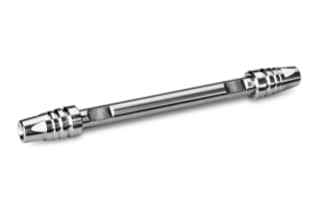
|
Chemistry |
Amide |
|
Separation Mode |
Hydrophilic Interaction (HILIC) |
|
Particle Substrate |
Hybrid |
|
pH Range Min |
2 pH |
|
pH Range Max |
11 pH |
|
Maximum Pressure |
10000 psi (690 Bar) |
|
Endcapped |
No |
|
Silanol Activity |
Low |
|
Particle Shape |
Spherical |
|
Particle Size |
2.5 µm |
|
Endfitting Type |
Parker-style |
|
Pore Size |
130 Å |
|
Format |
Column |
|
Surface Area |
185 |
|
System |
UPLC, UHPLC |
|
Particle Technology |
BEH |
|
USP Classification |
L68 |
|
Inner Diameter |
4.6 mm |
|
Length |
100 mm |
|
Carbon Load |
12 % |
|
UNSPSC |
41115709 |
|
Brand |
XBridge |
|
Product Type |
Columns |
|
Units per Package |
1 pk |

XBridge BEH Amide Column, 130Å, 2.5 µm, 4.6 mm X 100 mm, 1/pk
The XBridge BEH Amide XP Column contains a tri-functionally connected amide phase that is pH stable from 2 to 11, allowing it to separate polar analytes with a wide range of polarity, structural moiety, and pKa. Your system will retain extremely polar compounds like carbohydrates and sugars when you use the XBridge BEH Amide XP Column. The BEH particle technology in the XBridge BEH Amide XP Column improves hydrolytic stability and particle strength, preventing any LC/MS leakage in the system.
The XBridge BEH Amide XP Column has a particle size of 2.5 m and is created within packaging utilizing ultra-low dispersion hardware. It is based on the eXtended Performance [XP] column technology, which allows for improved separation performance, robustness, and throughput for HPLC investigations while also facilitating the transfer to UPLC adoption.
XBridge XP Columns cover a comprehensive variety of options when it comes to HPLC, UHPLC, and UPLC systems. The XBridge BEH Amide XP Column is highly customizable, allowing you to easily develop robust methods with a wide range of mobile phases and pH ranges. This lab equipment will assist in developing samples with remarkable chemical stability at high pH and temperatures, even when the bulk loading of basic chemicals is increased.
To review additional collections of lab equipment from Waters, you may review our catalog or browse through our website, from where you can shop for lab equipment to fulfill all your laboratory requirements.
Compatible with the XBridge BEH Amide Column, you should check out the XBridge BEH Amide XP VanGuard Cartridge, 130Å, 2.5 µm, 3.9 mm X 5 mm, 3/pk; XBridge BEH Amide VanGuard Cartridges are used to extend analytical column lifetime and performance by removing particulate contamination from the mobile phase stream. This cartridge is optimized to protect all 4.6 mm I.D. XBridge BEH Amide analytical columns containing 2.5 µm sorbent particles.
What Is BEH's Importance In Chromatography?
One of the primary enablers underlying UPLC technology is the BEH (Ethylene Bridged Hybrid) particle, which comes in a variety of pore sizes and bonded phases, allowing for both reversed-phase and hydrophilic contact chromatography. The approach may be used to evaluate a variety of biopharmaceutical compounds, including tiny and big molecules. Because hybrid particle technology is chemically stable, it can be used in a larger pH range [pH 1-12]. As a result, it will be possible to design a diverse and reliable separation technology for method development. BEH particle technology comes in a variety of HPLC particle sizes [2.5, 3.5, 5, and 10 m], allowing for a seamless transition from HPLC to UPLC.